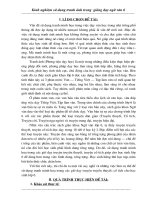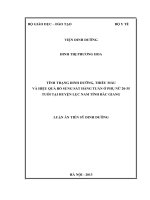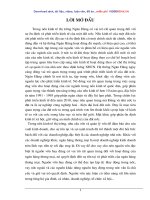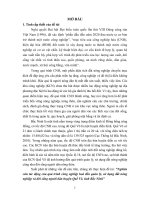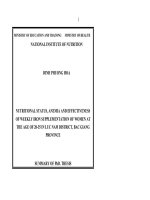Hiệu quả của việc sử dụng tranh ảnh trong việc dạy từ vựng tại trường smart kids, tỉnh bắc ninh
Bạn đang xem bản rút gọn của tài liệu. Xem và tải ngay bản đầy đủ của tài liệu tại đây (577.66 KB, 49 trang )
CANDIDATE’S STATEMENT
I hereby certify that this thesis is my own work and effort and that it has not been
submitted anywhere for any award.
1
ACKNOWLEDGEMENTS
I would like to express my gratitude to all the people who gave me the possibility to
complete this thesis.
First of all, I would like to express my sincere and deep gratitude to my supervisor,
Dr. Hà Cẩm Tâm for her invaluable advice, careful instruction and helpful
encouragement during the process of writing this minor thesis.
Secondly, I would also like to express my sincere thanks to all of my lecturers in the
Faculty of Post- graduate Studies, the University of Foreign Languages and
International Studies for useful lectures and suggestion that have inspired and
helped me much in the clarifications of my study.
My special thanks also go to all teachers and students at Smart-kids school in Bac
Ninh province who contribute to the idea budget and spent time completing
observation and tests.
Finally yet importantly, I would also like to express my genuine appreciation to my
friends and my family for their unending support and words of encouragement. If
there had not been great help from the above people, the study could not have been
fulfilled.
2
ABSTRACT
Vocabulary is one of the important elements in teaching English. In acquiring a
foreign language, learning vocabulary is considered as one of important tasks. At
Smart-kids school, learning and teaching vocabulary is a major concern, too. In an
attempt to investigate the effect of pictures in teaching vocabulary the study has
been conducted in the form of an action research. The participation of the study
comprised 30 kindergarten students. They were randomly assigned into two
homogeneous groups each consisting of 15 learners. The experimental group used
pictures in teaching vocabulary but the control group didn’t use. The classroom
observation and tests were the main instruments employed for the data collection.
The result showed that the students in the experimental group outperformed the
students in the control group in their vocabulary knowledge. It means that the
contribution of pictures in teaching vocabulary to students led to higher level of
vocabulary improvement. Therefore, using pictures in teaching vocabulary seems to
be more effective than not using.
3
TABLE OF CONTENTS
DECLARATION
i
ACKNOWLEDGEMENTS ii
ABTRACT iii
TABLE OF CONTENTS iv
LIST OF TABLES AND CHARTS vii
PART A. INTRODUCTION 1
1. Rationale of the study 1
2. Aims and significant of the study 2
3. Scope of the study 2
4. Research methodology 2
5. Organization of the study 3
PART B. DEVELOPMENT 4
CHAPTER 1. LITERATURE REVIEW 4
1.1. Vocabulary teaching 4
1.1.1. Stages in vocabulary teaching 5
1.1.1.1. Presentation 5
1.1.1.2. Practice 5
1.1.1.3. Production 6
1.1.1.4. Review 7
1.1.2. Techniques in vocabulary teaching 7
1.1.3. Factors affecting vocabulary retention 9
1.1.3.1. Memory 9
1.1.3.2. Motivation 11
1.1.3.3. Person-dependent factors 13
4
1.2. Pictures in teaching vocabulary 15
1.2.1. The meaning of pictures 15
1.2.2. The types of pictures 16
1.2.3. Issues of using pictures in teaching vocabulary 17
1.2.4. Activities using pictures in teaching vocabulary 19
1.2.5. Review of previous studies on using pictures in teaching vocabulary 20
CHAPTER 2. METHODOLOGY 22
2.1. Research question 22
2.2. Informants 22
2.3. Planning 23
2.4. Acting 24
2.5. Observing 25
2.6. Reflecting 25
CHAPTER 3. DATA ANALYSIS AND DISCUSSION 26
3.1. Classroom observation 26
3.1.1. Memory 26
3.1.2. Interest 28
3.1.3. Classroom interaction 31
3.2. Test result 33
3.2.1. The progress tests 33
3.2.2. The final test 34
3.3. Finding and comments 36
PART C. CONCLUSION 39
1. Conclusion 39
2. Implications 40
3. Limitations and recommendations for further studies 40
REFERENCES 42
APPENDIX I
APPENDIX 1 I
5
APPENDIX 2 IV
APPENDIX 3 VI
APPENDIX 4 VIII
LIST OF TABLES AND CHARTS
Table 1: The number of students remembers 3
and 4 words
………………………………. 27
Table 2: The progress tests …………………………………33
Chart 1: The students’ participation in learning
activities in class
…………………………………28
Chart 2: Classroom interaction …………………………………32
PART A: INTRODUCTION
6
Part A – Introduction- provides the background to the study and statement of
the problem, the aims, the research question, the scope of the study as well as the
research methodology. It also outlines the organization of the thesis.
1. Rationale of the study
English teaching involves four language skills: listening, speaking, reading
and writing. One of the main tasks assigned to foreign language teaching at school
is that of training students to be communicatively competent. Speaking is "the
process of building and sharing meaning through the use of verbal and non-verbal
symbols, in a variety of contexts" (Chaney, 1998: 13). In any second language
teaching and learning, speaking is always believed to be the most vital skill and in
teaching speaking, vocabulary is the most important thing. “If language structures
make up the skeleton of language, then it is vocabulary that provides the vital
organs and the flesh.”(Harmer 1993: 153). Cook’s (2000) conclusion is also
consistent with Wilkins in that “Grammar provides the overall patterns, vocabulary
the material to put into those patterns”. Or some authors, led by Lewis (1993) argue
that vocabulary should be at the center of language teaching, because ‘language
consists of grammaticalised lexis, not lexicalised grammar’. From the statement, it
can be seen that vocabulary functions as a cornerstone without which any language
could not exist. Speaking would be meaningless and perhaps impossible having
only structure without vocabulary. Therefore, the English teacher has to be able to
organize teaching and learning activities; they have to give materials by using a
suitable technique and master the lesson effectively. Especially in learning
vocabulary, teachers must make the students able to memorize such words in
English language and group of new words. Celce Maria stated that research in first
and second language acquisition suggest that initial teaching priorities for language
areas should be vocabulary, grammar, and pronunciation. Therefore, the English
teacher has to be able to organize teaching and learning activities and they have to
give materials by using a suitable technique and master the lesson effectively.
Especially in learning vocabulary, teachers must make the students able to
7
memorize such words in English language and group of new words. The statements
above mean, vocabulary is important to teach and teachers must try to find the most
effective way to help learners retain new words in long term memory.
As a teacher at Smart-kids schools, I realize that teaching vocabulary is
major concern because at the age of five, students cannot write or read and the
effective way to teach is through pictures. Therefore, I choose this topic to
understand more about the effectiveness of using picture in teaching vocabulary.
2. Aims and significance of the study
This study is aimed at finding out the effectiveness of using picture in
teaching vocabulary at Smart-kids school based on the understanding of vocabulary
and pictures in linguistic notion and the situation of teaching and learning there.
Through this, some implications to solve these problems will be suggested.
The result of the research will be helpful for many English teachers in many
schools especially Smart-kids school in Bac Ninh province. From this, the teachers
will find an effective ways and apply many activities in class to attract students
attention in learning new words. Basing on suggestions in this research, teachers
can have their own way to teach their students.
3. Scope of the study
I cannot go into details of all parts of language theory and practice because
of the limited time, the shortage of reference books, and the students’ language
ability. This is also a wide topic so I mainly focus on the effect of using picture in
teaching vocabulary in the field of memory, interest and interaction.
4. Research methodology
This methodology used in the study is those of an action research. Thus, it
applied both qualitative and quantitative approaches with two methods of data
collection. The qualitative data were collected from observation and the quantitative
data were collected from tests including two progress tests and one final test.
5. Organization of the study
8
This minor thesis is composed of three parts as follow:
Part A - Introduction: The first part presents rationale, aims and
significance as well as scope of the study, research methodology and organization
of the study.
Part B - Development: The second part consists of three chapters. Chapter 1
is for literature review, which provides the theoretical background of the study.
Chapter 2 is methodology which represents the research question, describes
informants and the design of the study. Chapter 3 presents the data analysis of
classroom observation and test then discussion.
Part C – Conclusion: The final part summarizes the major findings of the
experiment, voicing some implications for language teachers in teaching vocabulary
and suggesting some recommendations for further studies.
PART B: DEVELOPMENT
9
CHAPTER 1: LITERATURE REVIEW
In this chapter, relevant literature is reviewed, underlying the necessity and
the relevance of the study. In other words, background knowledge on vocabulary
teaching in general and vocabulary teaching through pictures in particular is looked
at critically to set up the theoretical framework for further investigation.
The first section of this chapter is devoted to theoretical aspects of
vocabulary teaching and the second section of this chapter is about pictures in
language teaching.
1.1. VOCABULARY TEACHING
It cannot be denied that vocabulary is one of the most important language
elements among pronunciation, grammar and vocabulary. According to McCarthy
(1990:101), “vocabulary is the biggest component of any language. If you do not
know enough vocabulary you will not be able to express yourself adequately”. In
addition, “no matter how will the students learn grammar, no matter how
successfully the sounds of second language are mastered without words to express a
wider range of meaning, communication just cannot happen in any meaningful
way” (McCarthy, 1990: piii). From this, it can be said that teaching vocabulary
plays an important role, too. Although traditionally, the teaching of vocabulary
above elementary levels was mostly incidental, limited to presenting new items as
they appeared in reading or sometimes listening texts. This indirect teaching of
vocabulary assumes that vocabulary expansion will happen through the practice of
other language skills, which has been proved not enough to ensure vocabulary
expansion. Some authors, led by Lewis (1993) argue that vocabulary should be at
the center of language teaching, because “language consists of grammaticalised
lexis, not lexicalized grammar”. Nowadays it is widely accepted that vocabulary
teaching should be part of the syllabus, and taught in a well-planned and regular
basis. To understand more about vocabulary teaching, it is necessary to describe
stages in vocabulary teaching.
1.1.1. Stages in vocabulary teaching
10
Basically as proposed by Doff (1988:98), there are four stages in teaching
vocabulary namely presentation, practice, production, and review.
1.1.1.1. Presentation
The first is presentation, one of the most important and complex preliminary
stages in teaching vocabulary. The title of this stage indicates clearly its function is
introducing new lexical items to learners. As suggested by Thornbury (2002: 75-76)
learners need to learn both the meaning and the form of a new word. He also
emphasizes some major factors subject to the number of word to be presented such
as: the learner’s level (beginner, intermediate or advanced), learner’s likely
familiarity with the words.
According to Gairns and Redman (1986: 73-75), there are three techniques
used in the presentation of new vocabulary items. The first one is visual techniques
including mime, gestures, and visuals such as flashcards photographs, blackboard
drawings, wall charts, and realia. The second one is verbal techniques: use of
illustrative, situations, use of synonymy and definition, contrasts and opposites,
scales, and examples of the type. The last one is translation. It is considered a
quick, easy, and effective way of conveying the meaning of vocabulary. Similarly,
Thornbury (2002:77) suggests a variety of techniques in introducing vocabulary
such as translation, real things, pictures, gestures, definitions, and situations. On the
other hand, Doff (1988, p. 96) groups these techniques into four categories:
showing the meaning of words visually, showing the meaning of words in context,
using synonyms or antonyms and translation. He adds that a combination of the
techniques should be implemented when it comes to the effectiveness of presenting
meaning of new words.
1.1.1.2. Practice
When the teacher presents the meaning of new words, they can only become
student’s passive vocabulary, and students may easily forget them and do not know
how to use properly. Students’ vocabulary can only be activated effectively if the
teacher gives the learners opportunities to practise them through vocabulary
11
exercises or activities. Thornbury (2002:93) underlines the popular belief that
“practice makes perfect”. In addition, he shares his opinion about the action of
moving from short-term memory into permanent memory. In order to ensure long-
term retention, words or lexical items need to be put into practice. In this case,
teacher finds a suitable way to help students with some kinds of practical exercises
to help students become more familiar with the words they have learned: matching
pictures to words, matching parts of words to other parts, using prefixes and
suffixes to build new words from given words, classifying items into lists, using
given words to complete vocabulary specific task, filling in crosswords, grids or
diagrams, filling in gaps in sentences and memory games. Besides, Thornbury
(2002: 93-94) points out that there is a variety of tasks which can be used in order to
help move words into long-term memory. They can be divided into five types in
order of least cognitively demanding to most demanding: identifying, selecting,
matching, sorting, and ranking and sequencing.
1.1.1.3. Production
Developing fluency with known vocabulary is essential to help learners
make the best use of what they have already known. In this stage, students are
advised to complete high-level tasks namely production tasks (Thornbury, 2002:
100). He recommends that learners should produce something as a product of their
own. In this way, learners will turn words from receptive to productive and put
them into long-term memory. In this stage, there are two major types that teachers
may have used very often: completion and creation. Basing on Hunt and Beglar
(2002: 261), fluency building activities recycle already known words in familiar
grammatical and organizational patterns so that students can focus on recognizing
or using words. To develop learners’ production of vocabulary, the following
activities are held such as first and second language comparisons and translation
carried out chunk for-chunk, rather than word-for-word aimed at raising language
awareness; repetition and recycling of activities, for example, summarizing a text
orally one day and again a few days later to keep words and expressions that have
12
been learned active, working with language corpuses created by the teacher for use
in the classroom. Besides, Doff (1988) judges communicative activities such as
information exchanging, elicitation of student-talk, games and role plays as the
most effective ways to motivate students to be more actively involved in the
speaking activities to produce the words they have known.
1.1.1.4. Review
This process aims at helping students acquire active, productive
vocabularies. In the reviewing stage, students have more chance to use language
and receive feedback. It can be seen that games and communicative activities are
the best way to help students to review words. Besides, visual aids can make
vocabulary revision more interesting and effective. Revision can be done in both
individuals and collaboration. Doff (1988: 97) expresses that vocabulary is mainly
reviewed through the warm up steps. It means that teacher can review new words in
the later lesson. It aims at refreshing memories or as a preparation for a new
presentation.
1.1.2. Techniques in vocabulary teaching
Learners acquire vocabulary in various ways. Students are exposed to a lot of
new vocabulary during lessons: by the teacher, by texts or other materials they work
with. A lot of this vocabulary is automatically absorbed. (Harmer 1993: 159).
Besides this incidental acquisition there are “pre-planned lesson stages in which
learners are taught pre-selected vocabulary items” (Thornbury 2004: 75). Various
techniques and activities are aimed directly at learning vocabulary, which is usually
put into sets of somehow related words, often by topic or meaning. As McCarthy
(1992) suggests, before presenting new language, pre-teaching activities might be
beneficial “to activate existing knowledge to make the encounter with new words
more meaningful” (McCarthy 1992: 108). Pre-teaching activities often arouse
students’ attention and desire to explore a particular topic or subject in greater
detail.
13
Both McCarthy (1992: 110) and Thornbury (2004: 76) suggest two general
possibilities of arranging vocabulary presentation. The teacher provides the learners
with the meaning of the words and then progresses to introduction of their forms or
vice versa – the form is introduced first, followed up with illustration of the
meaning. In the latter, forms are often presented in text or another form of context
and students are encouraged to discover meanings and other properties of words
themselves. This type of activity is called the discovery technique (Harmer 1993:
160). There are many possibilities how to explain or illustrate the meaning of the
words. In the first place, it is necessary to mention techniques typical for ‘Direct
Method’ as Thornbury, 2004 specifies them “using real objects or pictures or
mime.” (Thornbury 2004: 78).
The same author continues that these means are especially appropriate for
teaching elementary levels, where many concrete objects are taught. These types of
presentation are usually supplemented with the use of total physical response, which
is a technique where the teacher gives commands and students perform the actions.
In total physical response, “the intention is to replicate the experience of learning
one’s mother tongue” (Thornbury 2004: 79). Techniques for using pictures are
furthermore explored as Harmer (1993: 161-162) suggests, sense relations,
definition and direct translation of words might function as yet another helpful
tool for clarifying the meaning.
Thornbury (2004) listed these options as well and furthermore included an
idea of clarifying the meaning by examples, such as “providing an example
situation” or “giving several example sentences” (Thornbury 2004: 81)
All these techniques are more or less useful for a particular situation, level
and vocabulary, the best way would be in many cases to combine them and use
several together. Besides explaining the meaning in vocabulary presentation, it is
also important to focus on forms, since the sound of words is one of the aspects
influencing the organization of the mental lexicon (Thornbury 2004: 84; McCarthy,
1992: 110). This is arranged by various drilling activities. From experience, songs
14
and chants are very suitable for drills, providing rhythm, catchy rhymes and an
element of fun. As Thornbury (2004: 86-87) suggests, introducing the written form
of the word should follow not long after the presentation of the pronunciation. After
presentation, learners should be provided with plenty opportunities to practice the
newly gained language in accordance with the principles.
1.1.3. Factors affecting vocabulary retention
When considering variety of factors that affect the acquisition of vocabulary,
theorists and researchers present slightly different opinions. However, various
opinions meet at some points, and it is said that the retention of vocabulary may be
affected by some factors as follows:
- Memory
- Motivation
- Person-dependent factors
Therefore, understanding factors affecting vocabulary retention might help
teachers create more effective ways to teach vocabulary and find their own way to
find solution for teaching difficulties.
1.1.3.1. Memory
It can be seen that memory is important in learning new words. According to
Thornbury, 2002, there are two major types of memory: short term memory, long
term memory.
Short term memory is the brain capacity to hold a limited number of items of
information for periods of time up to a few seconds. It is the kind of memory that is
involved in repeating a word that you have just heard the teacher modeling. But
successful vocabulary learning involves more than holding words for a few seconds.
To integrate words into long - term memory they need to be subjected to different
kinds of operations.
Long-term memory can be seen as kind of filling system. This kind of
memory has an enormous capacity and its contents are durable over time. On the
basis of available research results, Thornbury has compiled a list of principles that
15
facilitate the transfer of learning material into the long term memory. These include
multiple encounters with a lexical item preferably at spaced intervals, retrieved and
use of lexical items and cognitive depth, affective depth, personalization, imaging,
use of mnemonics and conscious attention that is necessary to remember lexical
items.
+ Repetition - repetition of encounters with a word is very important, useful
and effective. If the word is met several times over space interval during reading
activities, students have a very good chance to remember it for a long time.
+ Retrieval - another kind of repetition. Activities, which require retrieval,
such as using the new items in written tasks, help students to be able to recall it
again in the future.
+ Spacing - being useful to split memory work over a period of time rather
than to mass it together in a single block.
+ Use - putting words to use, preferably in an interesting way, is the best way
of ensuring they are added to long-term memory. This is so called “use it or lose it”
principle.
+ Cognitive depth - the more decisions students make about the word and the
more cognitively demanding these decisions are, the better the word is remembered.
+ Personal organizing - personalization significantly increased the
probability that students will remember new items. It is achieved mainly through
conversation and role-playing activities.
+ Imaging – easily visualized words are better memorable than those that do
not evoke with any pictures. Even abstract words can be associated with some
mental image.
+ Mnemonics - tricks to help retrieve items or rules that are stored in
memory. The best kinds of mnemonics hare visuals hand keyword techniques.
+ Motivation - strong motivation itself does not ensure that words will be
remembered. Even unmotivated students remember words if they have to face
appropriate tasks.
16
+ Attention - impossible to improve vocabulary without a certain degree of
conscious attention.
1.1.3.2. Motivation
As it has been said one of the factors that have a strong impact on success or
failure in learning English is motivation. If students miss motivation for studying
English, it will be very hard to make them cooperate. It can simply be said that
without motivation students would not do some activities and consequently there
would not be any effort to acquire a language. According to Rogers, ‘motivation…
is as much a matter of concern for the teacher as it is for the learner; it depends as
much on the attitude of the teacher as on the attitudes of the students’ (Rogers 1996:
66). On the other hand, Williams & Burden suggest that motivation is a ‘state of
cognitive arousal’ which provokes a ‘decision to act’ as a result of which there is
‘sustained intellectual and/or physical effort’ so that the person can achieve some
previously set goal’ (Williams and Burden 1997: 120). Besides, another theory on
motivation can be seen from Littlewood’s perspective (1998: 53) that “in second
language learning as in every other field of human learning, motivation is the
crucial force which determines whether a learner embarks on a task at all, how
much energy he devotes to it, and how long he perseveres. It is a complex
phenomenon and includes many components: the individual’s drive, need for
achievement and success, curiosity, desire for stimulation and new experience, and
so on”. Keller (1984) (quoted in Ellis, 1994) sees 'interest' as one of the major
components of motivation, defining it as “a positive response to a stimuli based on
existing cognitive structures in such a way that learners’ curiosity is aroused and
sustained”.
Students must be motivated by some basic kinds of motivation, which
include intrinsic and extrinsic motivation. According to Harmer, intrinsic
motivation is commonly defined as an internal drive. This is something that
students want to do themselves because they are personally interested in it (e.g.
acquiring the knowledge of language). A typical example of intrinsic motivation is
17
an interest or a hobby, i.e. an activity carried out for its own sake. On the contrary,
extrinsic motivation is influenced from outside. Students carry out activities
because they are expected or forced to do them. It may be the compulsory subjects
in school curriculum, a need to satisfy parents’ expectations, longing to be praised
or an idea of a better career. The ordinary motives are tangible rewards. On the
other hand, intrinsic motivation is concerned with the factors taking place inside the
classroom while extrinsic motivation is concerned with factors outside the
classroom. Harmer points out that intrinsic motivation is very important in students’
success or failure. What happens in the classroom is very important in establishing
students´ attitude to a language. In his opinion, extrinsic motivation includes
situations in which students believe that managing of the target language will be a
means for getting a better job, position or it will help them to integrate into a
particular culture environment. This stresses the fact that students’ attitude to
learning can be predominantly affected by members of a community. But other
factors participating in the learning process can also essentially affect it. They are
physical conditions, teaching methods, success or failure and especially a teacher.
All of them have an important impact on learning a foreign language.
To young learners or children, motivation in teaching and learning is
somehow different. Children do many things simply because they want to do them.
Selecting a toy or a shirt to wear is the result of "intrinsic motivation." The child
makes her own choice and achieves satisfaction from both the act of choosing and
from the opportunity to play with the toy or wear the shirt. Since the activity is
generating the motivation, it is mostly self-sustaining for as long as the child wants
to continue the activity. Children also engage in some activities because adults tell
them to, or in an effort to please another party. These activities are "extrinsically
motivated." When a child is extrinsically motivated, the reward comes from outside
the child-it has to be provided by someone else, and has to be continually given for
the child to remain motivated enough to continue the activity. It is more difficult
for a child to sustain extrinsically motivated activity because of this reliance upon
18
some outside force. Since intrinsically motivated activity is more rewarding in and
of itself, children learn more from this sort of activity, and they retain that learning
better. Intrinsically motivated children are more involved in their own learning and
development. In other words, a child is more likely to learn and retain information
when he is intrinsically motivated - when he believes he is pleasing himself. Parents
can build on this sense of confidence by guiding their child's play and activities
while still giving the child a range of options. This unstructured play is an essential
element of the child's motivation, learning, and development.
1.1.3.3. Person-dependent factors
According to Lightbown and Spada (1999), person-dependent factors include
age, language aptitude, intelligence, attitude and personality. Rubin and Thomson
(1994) also consider the factors including age, aptitude, attitude, personality,
learning style and past experiences. In this thesis, these factors are considered in a
logical way to understand how they affect vocabulary acquisition in second
language acquisition.
Age is one of the factors that influence second language learning. It is widely
believed that children learn second languages quickly, without effort and that the
younger they are, the more skilled in acquiring a second language they will become.
Brown (2000) adds that there are differences between child and adult language
learning that require explanation based on neurological, psychomotor, linguistic,
cognitive and affective considerations in order to avoid some misunderstandings
arising from erroneous analogies drawn between first language and second
acquisition. On the other hand, according to Ellis (1985) the route of second
language acquisition is not influenced by the starting age, but there is a relationship
between the rate of learning and the age of the learners. Adolescents learn faster
than adults and children as far as grammar and vocabulary are concerned. Although
young learners do not learn as fast as older ones, they are prompt to gain a higher
overall success because of a longer exposure to the language. He also provides
some explanations of the research results. The studies do not support the critical
19
period hypothesis, which states that children can acquire a language naturally and
with no effort to some ages. The starting age is important only as far as
pronunciation is concerned. It can be said that each age brings some advantages and
disadvantages to the learning process and the decision when to start learning a
foreign language depends on the situation of the individual learner. Students are
taught in all age groups and teachers’ task is to use appropriate methods to suit the
demands of a given age group.
Intelligence has been defined in many different ways including logic,
abstract thought, understanding, self-awareness, communication, learning, having
emotional knowledge, retaining, planning, and problem solving. The studies on
intelligence show a strong relationship between intelligence and acquisition of a
foreign language but only as far as academic skills are concerned. Learners with
high intelligence quotient achieve better results on language tests. It is proved that
intelligence can predict the rate and success of second language acquisition in the
formal language classroom. “The ability to perform well in standard intelligence
tests correlates highly with school related second language learning, but is unrelated
to the learning of a second language for informal and social functions” (Spolsky,
1989: 103).
Attitude takes a very important role in language acquisition. Gardner and
Lambert have investigated a number of different attitudes, which were classified by
Stern (1983:376-377) into three types:
+ Attitudes towards the community and people who speak second language
+ Attitudes towards learning and language concerned
+ Attitudes towards languages and language learning in general.
Certain personality characteristics and general interest in foreign languages
of learners can influence them in a positive or negative way. It is also important
how they feel about learning a particular language in a particular course and from a
particular teacher. It is obvious that learners who have positive attitudes learn more,
but also learners who learn well acquire positive attitudes. So, it cannot be denied
20
that understanding factors affecting vocabulary retention might help teachers create
more effective ways to teach vocabulary.
1.2. PICTURES IN TEACHING VOCABULARY
1.2.1. The meaning of pictures
Pictures are kinds of visual instruction materials which might be used more
effectively to develop and sustain motivation in producing positive attitudes
towards English and to teach or reinforce language skills. Many definition of
picture are shown.
According to Cobuild (1987: 1320), a picture can be defined as “a visual
representation of image painted, drawn, photographed or otherwise rendered on a
flat surface.” Meanwhile, according to Andrew Wright (1989: 29), “Picture is not
just an aspect of method but through its representation of place, object, and people,
it is essential part of the overall experiences.” In addition, Hornby (2007: 1138),
picture is a description that gives you an idea in your mind of what something is
like. It means that using picture will make the children easier to remember and
understand the new vocabulary that they get. Besides, Vernon S Gerlach stated
different definition of picture: “Pictures area two dimension visual representation of
person, places, or things. Photograph prints are most common, but sketches,
cartoons, murals, cut outs, charts, graphs and maps are widely used….” Through
pictures, learner can see people, place and things from areas for outside their own
picture can also represent image from ancient times or portray the future.
Thus, the most outstanding feature of a picture is its visibility to learners so
that teachers can use it for many pedagogical purposes. The use of pictures are more
efficient and practical than words, they are easier to recall and to remember than
words, further more they expose real life situation although it happened a long
time ago. It is also explained by Vernon, S.Gerlach and Donald that “picture may
not only be worth a thousand miles. From the meaning of pictures above, it
indicates that the pictures has exchanged and represented the real object into a
21
simple device which has displayed a series of places, objects, person or even
experience.
1.2.2. The types of pictures
Pictures can be categorized basing on their size and design. Due to teaching
purposes, teachers have to consider carefully which types of pictures are needed.
According to Brazyna Szyke (1981), pictures are divided into two main
types. The first type is that pictures of individual persons or thing may be used
mainly at the elementary level to introduce or test vocabulary items. For example, a
house, a dog, a man, a girl. The second type is that pictures of situations in which
person and object are “in action” between objects and people can be perfect
teaching aid for introducing or reviewing grammatical or structures. For example:
football, meeting, market.
Additionally, Betty Morgan Bowen (1973: 13-31) has different ways to
classify pictures in the book “Look Here! Visual Aids in Language Teaching”.
The first type of pictures is wall charts and wall pictures. Most wall charts
consist of combination of visual and verbal material. They aim at giving
information on topic. A wall picture, on other hand, is simply a large illustration of
a scene or event, or a set of scenes or events (Bowen, 1973). Good wall pictures are
relevant, easy to recognize, suitable size and easy to understand. The best of storing
wall pictures and wall charts is to display on the classroom wall. The difference
between wall charts and wall pictures is the way they are used. Wall pictures are
often used for the whole class but wall charts are most part unsuitable for whole
class teaching because they are usually complex, with printing too small to be seen
by the learners.
The second type is sequence pictures. They are series of pictures on a single
subject. They “reveal their story or theme like a strip cartoon, in a connected set of
illustrations” for good selection and display the teacher needs make the titles and
captions large enough to read, or omit them all together and do the describing
orally. In addition, the teacher may know how to link pictures to form a set, thus
22
forming the continuity of characterization, setting and subjects from picture to
picture. As learners look through the sequence, each picture helps to clarify the
meaning of the others.
The third type is flash cards. Flash cards are word flash cards and picture
flash cards. Picture flash cards are teacher’s accompanying guide. They are useful
for the representation of a single concept, such as an object or in action. On the
other hand, word flash cards are on which words have been printed can be held up
rapidly by the teacher before class. They include visual as well as text magazine
pictures drawing maps and diagrams. The cards are easy to store and to carry to the
classroom. They are easy for the teacher and the students to handle and use at the
appropriate moment.
Finally, drawing on the board can easily caught learners’ attention, change
the pace of lesson and encourage naturals of response. The teacher can organize
different activities through drawing on the board. He/she can teach vocabulary
spelling, pronunciation, drills and so on (Bowen, 1973). Before drawing, the teacher
should think carefully to make a visual aid and consider the purpose, the specific
learning points of the lesson, the characteristics of learners especially young
learners.
1.2.3. Issues of using pictures in teaching vocabulary
In this part, many advantages and disadvantages of using pictures in teaching
vocabulary are considered.
Firstly, the use of pictures gives teachers a number of benefits. It can be said
that pictures are one of these valuable aids. They bring “images of reality into the
unnatural world of the language classroom” (Hill, 1990:1). Pictures bring not only
images of reality, but can also function as a fun element in the class. Sometimes, it
is surprising, how pictures may change a lesson, even if only employed in
additional exercises or just to create the atmosphere. As Bowen said that the use of
pictures in speaking lesson is likely to result in less teaching talking time and more
student participation. Pictures meet with a wide range of use not only in acquiring
23
vocabulary, but also in many other aspects of foreign language teaching. Wright
(1990: 4-6) demonstrated this fact on an example, where he used one compiled
picture and illustrated the possibility of use in five different language areas. His
example shows employing pictures in teaching structure, vocabulary, functions,
situations and all four skills. Furthermore he pointed out that “potential of pictures
is so great that only a taste of their full potential can be given” in his book
(Wright 1990: 6). To be more specific, beside lessons where pictures are in the
main focus, they might be used just as a “stimulus for writing and discussion, as an
illustration of something being read or talked about, as background to a topic and so
on” (Hill, 1990: 2). There are many reasons of using pictures. As Wright (1990: 2)
pointed out, they are motivating and drawing learners’ attention, providing a sense
of the context of the language and giving a specific reference point or stimulus.
Additionally, Hill (1990:1) listed several advantages of pictures, such as
availability, cheap, flexibility - easily kept, useful for various types of activities.
However, using pictures in teaching language has their own limitation. The
first is that in teaching vocabulary, pictures are not suitable or sufficient for
demonstrating the meaning of all words (Thornbury, 2004: 81). It is very difficult to
illustrate the meaning of some words, especially the abstract ones such as ‘opinion’
or “impact”. The second is that it cost much time in finding the right pictures for a
specific type of activity for a beginning teacher who lacks his or her own collection.
Therefore, how we can use pictures effectively is a major concern. It demands
teachers using general methodological knowledge in a flexible way. It is important
to find a balance and not to use pictures or visuals only but to combine them with
other techniques and different types of stimuli such as movement, verbal stimuli
and sound. Moreover, pictures used for demonstration of the meaning should be
repeatedly connected with the spoken and subsequently also written form of the
word of language.
24
1.2.4. Activities using pictures in teaching vocabulary
The benefit of using games in language teaching is absolutely clear. There
are many ways applying pictures in teaching vocabulary in classroom so it requires
careful considerations from language researchers and teachers. Also teachers need
to look deep into their class situations as well as their students’ background
knowledge and what items will be taught, too. When I carry this research, many
activities which use pictures in teaching vocabulary are really helpful. In this thesis,
I only name some of them.
Total physical response game. The teacher says the word and the students
express the corresponding action and vice versa.
Exchange picture game. Each group had 5 students with 5 picture cards.
The cards are shuffled and distributed equally among all members of the group. The
first player asks any player in the group for a card he or she needs. If the asked
player has the card, he or she must give it to the first player and gets one card back
in exchange. The first player then asks another player for another card. If the asked
player does not have the required card, there is no exchange and it is the other
players (the asked ones) turn to ask somebody else for a card. The game can
continue until everybody gets their sets of cards.
Bingo picture game. In this game, every student gets a slightly different grid
with small pictures of action. The teacher calls out the words and students cross the
corresponding pictures if they have it on the grid. Whoever crosses all his and her
pictures first, shouts “Bingo” and becomes the winner.
Flashcards at Dawn. It motivates your students to speak English with this
flashcard game. It works very well with younger learners. Before you play, prepare
some flashcards of the target vocabulary. The teacher divides the class into two
teams. One student from each team stands back to back in the middle of the
classroom. Each student should hold one flashcard in front of them with the picture
side facing away from them. Both students then take three steps away from each
other before quickly turning around. This is similar to the pistols at dawn scenario.
25

